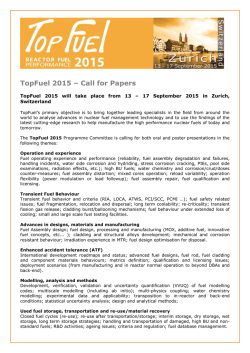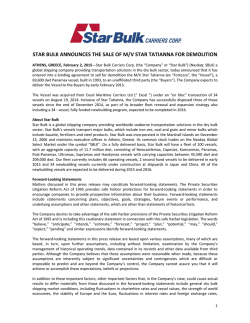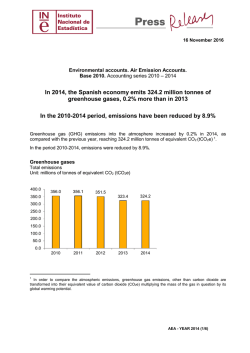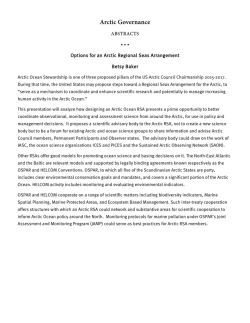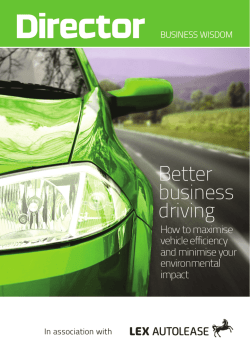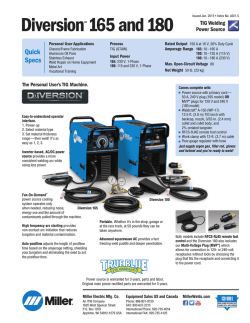
Download (pdf, 10.67KB) - The International Council on Clean
WORKING PAPER 2015-1 Air pollution from marine vessels in the U.S. High Arctic in 2025 Authors: Alyson Azzara and Dan Rutherford Date: 29 January 2015 Keywords: Marine emissions, marine black carbon, Arctic protection Executive summary Marine vessels are a large source of greenhouse gas and air pollutant emissions, including CO 2, NO X, SO X, particulate matter and black carbon, which impact local air quality, human health, and the global climate. Since the record-low Arctic Sea ice extent recorded in September of 2012, vessel activity and the associated impacts have been the focus of a number of different strategies for addressing operations, activities, and environmental concerns. The 2013 release of the U.S. National Strategy for the Arctic Region (NSAR) and its Implementation Plan (IP) in January 2014 highlight the issues of importance, including shipping and maritime infrastructure. A report recently released by the U.S Committee on the Marine Transportation System (CMTS) under the Department of Transportation (DOT)1 presented a set of scenarios for increased Arctic maritime activity in 2025. This study presents an emissions inventory based on the low- and mid-range scenarios indicating a potential 150 to 600 percent increase in emissions by 2025. Potential policies to constrain emissions growth include a global switch to cleaner marine fuels and the expansion of existing emission control area for marine vessels. Black carbon is second only to CO2 among anthropogenic emissions of climate pollutants (Bond et al, 2013)3. Lacking additional controls, it is estimated that global BC emissions from marine vessels may more than quintuple from 2004 to 2050, to a total of more than 744,000 tons BC, due to increased shipping demand. A growing share of those emissions will occur within the Arctic, due to vessel diversion. International regulations on pollution from ships are found within the IMO’s International Convention on the Prevention of Pollution from Ships (MARPOL 73/78). 4 MARPOL contains six annexes to address various sources of pollution from ships. Most recently MARPOL was amended through the “1997 Protocol,” which added Annex VI, Regulations for the Prevention of Air Pollution from Ships. MARPOL Annex VI sets limits on NOX and SOX emissions from ship exhaust, and prohibits deliberate emissions of ozone-depleting substances. Marine vessels are a large source of greenhouse gas and air pollutant emissions, including carbon dioxide (CO2), nitrogen and sulfur oxides (NOX and SOX), particulate matter (PM) and black carbon (BC), which impact local air quality, human health, and the global climate. According to the International Maritime Organization’s (IMO) 3rd GHG study2 emissions of NOX could increase globally by as much as 300%, and PM by 280% by 2050. There are two sets of emission and fuel quality requirements defined by Annex VI: (1) global requirements, and (2) more stringent requirements applicable to ships in Emission Control Areas (ECA). Global requirements include Tier II engine standards (NOX) and a global limit on marine bunker fuel sulfur content, currently set at 3.5% compared to a global average of 2.7%. This limit is scheduled to reduce to 0.5% in 2020, although members of the shipping industry are currently calling for IMO to delay the requirement until at least 2025. Regionally, ECAs can be designated for SOX and PM, and/or NOX, subject to a proposal from a Party to Annex VI. Currently, North America and the US Caribbean have established emission control areas for NOX requiring new-build ships to meet progressively tougher NOX standards in addition 1 3 1. Marine emissions in perspective 2 Azzara, A. J., Wang, H., and Rutherford, D. 2015. A 10-year Projection of Maritime Activity in the U.S. Arctic Region. A Report to the President. U.S. Committee on the Marine Transportation System, Integrated Action Team on the Arctic, Washington, D.C., 73 p. MEPC 67/INF.3, Third IMO GHG Study 2014 — Final report. Marine Environment Protection Committee, International Maritime Organization, London. © INTERNATIONAL COUNCIL ON CLEAN TRANSPORTATION, 2015 Bond et al. (2013). Bounding the role of black carbon in the climate system: A scientific assessment, Journal of Geophysical Research: Atmospheres, Vol 118, 5380-5552. 4 International Convention for the Prevention of Pollution from Ships (MARPOL), http://www.imo.org/About/Conventions/ ListOfConventions/Pages/International-Convention-for-thePrevention-of-Pollution-from-Ships-(MARPOL).aspx WWW.THEICCT.ORG AIR POLLUTION FROM MARINE VESSELS IN THE U.S. HIGH ARCTIC IN 2025 to limits for SOX emissions requiring the use of either 0.1% sulfur fuel or exhaust gas scrubbers. Neither ECA extends west of Kodiak, Alaska, and neither includes the Aleutian Islands or areas north into the Arctic. International regulations do not directly restrict the emission of black carbon from marine vessels, although it is generally understood that improving fuel quality also controls black carbon. This has been an ongoing topic of discussion for several IMO environmental subcommittees, including the Ship Design and Construction (SDC) subcommittee and the Pollution Prevention and Response (PPR) Subcommittee. Most recently, PPR recommended the IMO adopt the scientific consensus definition of black carbon and identified a need for additional research to identify the most appropriate measurement method(s) to measure marine BC emissions consistent with this definition.5 2. The Emerging U.S. Arctic Strategy In September of 2012, Arctic sea ice reached the lowest extent ever recorded.6 In the years since, a number of different strategies for addressing operations, activities, and environmental concerns in changing Arctic conditions have emerged. Active groups include U.S. departments and agencies, equivalents in other Arctic nations, and forums such as the Arctic Council and IMO. In 2013 the U.S. released a National Strategy for the Arctic Region recognizing the efforts of over 20 Federal and state agencies and departments and setting out priority actions reaching to 2018. The US Arctic Strategy is especially important because the U.S. will assume the chairmanship of the Arctic Council in 2015. The 2013 release of the U.S. National Strategy for the Arctic Region (NSAR)7 and its Implementation Plan (IP)8 in January 2014 highlight issues of importance for the Administration, including shipping and maritime infrastructure. In a recently released report compiled by the Department of Transportation, a set of scenarios for Arctic maritime activity in 2025 were presented. These included estimates for Arctic shipping growth based on current economic trends as well as additional diversion of vessels through the Arctic from other international shipping routes attributable to increasing access due to Arctic melting 5 Report of the Working Group on Air Pollution from Ships, PPR 2/ WP.5 (2015) Second Session of the Subcommittee on Pollution Prevention and Response, International Maritime Organization, 22 January, London. 6 National Snow and Ice Data Center. Accessed at http://nsidc.org/ arcticseaicenews/2012/09/arctic-sea-ice-extent-settles-at-recordseasonal-minimum/ 7 National Strategy for the Arctic Region, http://www.whitehouse.gov/ sites/default/files/docs/nat_arctic_strategy.pdf 8 Implementation Plan for the National Strategy for the Arctic Region, http://www.whitehouse.gov/sites/default/files/docs/ implementation_plan_for_the_national_strategy_for_the_arctic_ region_-_fi....pdf 2 INTERNATIONAL COUNCIL ON CLEAN TRANSPORTATION (table 1). Lastly, the report incorporated estimates for the impacts of oil and gas exploration on vessel activity. The report did not, however, explore the environmental impacts of increased shipping in terms of air emissions or the potential climate impacts from increases in short-lived climate pollutants such as black carbon. This working paper fills this gap by providing an emissions estimate for the projected traffic growth outlined in that report. A summary of the methodology, which applies the same set of assumptions for economic growth and vessel diversion as the DOT report, is provided in the Annex to this paper. This report focuses on the low- and mid-range diversion scenarios. The low-diversion scenario assumes 2% diversion from the Panama and Suez canals between July and November of 2025. This equates to approximately 1% of the total annual traffic through those canals. The mid-range estimate assumes that approximately 2% of annual vessel traffic through those canals is diverted through the Bering Strait in 2025, largely through the Northern Sea Route nearest to Russia. These diversion scenarios were combined with regional traffic growth projections to estimate potential criteria-pollutant emissions assuming the use of current fuels compared to the implementation of requirements for the use of low-sulfur fuel of either 0.5% or 0.1%. This paper does not address the potential increases from oil and gas exploration because of the complexity involved in estimating the vessel activity from an exploratory drilling program consisting of many types of vessels. The potential increases in vessel activity associated with oil and gas exploration as outlined in the DOT report would increase emissions from vessels beyond those estimated in this paper. Table 1. 2025 vessel diversion traffic in the U.S. Arctic with and without container vessels Annual Diversions w/o Containers by Rate Vessel type 5% 2%1 8% Annual Diversion with Containers 2% 5% 8% Tankers 57 141 226 57 141 226 Bulk Carriers 53 134 214 53 134 214 7 18 29 7 18 29 103 258 413 220 551 882 General Cargo Container Totals 117 293 469 Source: Azzara, A. J., Wang, H., and Rutherford, D. 2015. A 10-year Projection of Maritime Activity in the U.S. Arctic Region. A Report to the President. U.S. Committee on the Marine Transportation System, Integrated Action Team on the Arctic, Washington, D.C., 73 p. [1] Percent diversions are based on a July through November diversion from the Panama and Suez canals. These percent diversions equate to 1%, 2%, and 3%, respectively, of total annual volume through the canals. WORKING PAPER 2015-1 AIR POLLUTION FROM MARINE VESSELS IN THE U.S. HIGH ARCTIC IN 2025 3. Findings Based on emissions calculations for the low-growth vessel diversion, not including container ships, this increase in activity would cause at least a 150 to 230 percent increase above 2011 levels if the current fuel regulations continue in force through 2025. Assuming container vessel diversion, low-growth scenario emissions (table 2) would increase by 200 to 300 percent above 2011 levels, assuming continued use of heavy fuel oil (HFO) and marine diesel oil (MDO). Table 3. Emissions for mid-range growth scenario by fuel type, tonnes Pollutant 2011 Emissions 2025 emissions, Emissions baseline Percent with 0.5% fuel change sulfur fuel Percent change CO2 11,000 54,000 +390% 54,000 +390% NOX 253 1,470 +480% 1,400 +450% PM 17 120 +580% 32 +90% SOX 130 830 +520% 170 +30% BC 1.3 6.9 +435% 2.5 +90% Table 2. 2011 and 2025 low growth scenario emissions from Arctic Shipping for current fuels, 0.5%, and 0.1% sulfur fuel 2025 emissions (tonnes) Base fuel 0.1% sulfur Pollutant 2011 emissions (tonnes) Container diversion No container diversion No container diversion No container diversion CO2 11,000 34,000 28,000 28,000 28,000 NOX 250 910 740 700 700 PM 17 71 56 17 11 SOX 130 510 410 88 18 BC 1.3 4.9 3.5 1.2 1.2 In contrast to the continued use of HFO and MDO, the use of 0.5% sulfur fuel in 2025 for the low-growth scenario would reduce SOX emissions by 35% and BC by 5% relative to 2011, while keeping PM roughly constant. Additional reductions are seen for 0.1% fuel in 2025, the sulfur content currently required in ECAs, which decrease SOX, PM, and BC emissions by 87%, 35%, and at least 5%, respectively (figure 1). These decreases would occur despite an additional 120 ocean going vessels traveling through the U.S. Arctic compared with the 2011 baseline. 600 U.S. Emissions of PM10, SOX and BC from Shipping PM 500 SOX BC 6000 5000 400 4000 300 3000 200 2000 100 1000 0 0 current 2025 w/ containers 2025 w/o 2025 2025 containers 0.5% sulfer 0.1% sulfer Figure 1. Comparison of the potential reduction in emissions with the application of 0.5% and 0.1% fuel for Arctic vessels assuming the low growth scenario. WORKING PAPER 2015-1 Emissions of BC (kg) Emissions of PM and SOX (tons) 0.5% sulfur The low-growth scenarios are conservative estimates of vessel traffic growth in 2025. Additional growth is possible depending on a number of variables discussed in the DOT report, including infrastructure, insurance costs, and access due to the receding summer ice cover. Even without the inclusion of container vessels, emissions for the mid-range growth scenario (table 3) increase on the order of four to six times, with the largest increase in PM assuming the current fuel mix. Following the trend in the low-growth example, the use of 0.5% fuel reduces the potential 2025 emissions by a factor of five for SOX, PM, and black carbon over what would be emitted if no change in fuel sulfur content occurred. 4. Conclusions and Recommendations Combined with these potential increases in marine emissions, the current lack of regional environmental requirements for vessels transiting and operating in the U.S. Arctic may lead to an increasing impact on human health for Arctic communities and for the global climate. U.S. Departments as well as the Arctic Council and other Arctic governments have stressed the need for governments to consider the issues of community health and resilience. Additional emissions of climate-forcing pollutants such as black carbon and carbon dioxide combined with emissions of PM and NOX, which can be linked with respiratory health issues, may place additional stress on the Arctic environment and Arctic communities. INTERNATIONAL COUNCIL ON CLEAN TRANSPORTATION 3 AIR POLLUTION FROM MARINE VESSELS IN THE U.S. HIGH ARCTIC IN 2025 If diversion of vessels from other international routes increases, a growing share of pollution will come from larger vessels that are regulated internationally, and emissions from larger oceangoing vessels such as tankers and bulk carriers (2-stroke engines) will begin to outnumber smaller domestic vessels (figure 2). While the U.S. has adopted relatively strict NOX and PM domestic emission standards for smaller (C1 and C2) engines, there are currently no PM standards for engines on oceangoing vessels; furthermore, as noted above, there are widespread calls to delay the global 0.5% fuel sulfur limit to 2025 or beyond. The lack of regional restrictions in the Arctic leaves the area vulnerable to increasing emissions from international traffic that is less tightly regulated than under U.S. law. 2011 Fuel Use by Engine Type 4-stroke 2-stroke 31% 69% A number of policies can mitigate shipping emissions growth in the U.S. Arctic between now and 2025. Upholding the implementation date of 0.5% fuel sulfur, rather than delaying to 2025 or later, would provide benefits beginning in 2020 extending through the period of time when increases in vessel traffic are actively occurring. Extending the North American ECAs into Arctic waters would provide additional air-quality and human health benefits associated with 0.1% sulfur fuel and the use of Tier III engines for reduced NOX. Regional benefits would be increased by cooperative bilateral action with Canada, or additionally multilateral action with other Arctic nations to extend the Arctic ECA to larger areas of the Arctic. Other potential avenues for reducing Arctic emissions from vessels include designations of Marine Protected Areas (MPA) under domestic conservation frameworks, or possibly the designation of particularly sensitive sea areas (PSSA) under the IMO. Both options would provide guidelines for limiting vessel operations within the areas and specifying either speed limits or fuel requirements for operation, both of which could reduce emissions. As interest in the Arctic as an international shipping route increases and ice extent diminishes, growth in maritime activity becomes more likely. Initial steps to address the need for enhanced infrastructure, emergency response, and communication are under discussion; environmental policies to protect human health and the global climate should be considered in parallel. 2025 Fuel Use by Engine Type 4-stroke 2-stroke 31% 69% Figure 2. Share of 2011 and 2025 pollution as indicated by fuel use by engine type, low growth scenario without container vessel diversion. 4 INTERNATIONAL COUNCIL ON CLEAN TRANSPORTATION WORKING PAPER 2015-1 AIR POLLUTION FROM MARINE VESSELS IN THE U.S. HIGH ARCTIC IN 2025 Annex: Methodology This study closely follows the methodology adopted in the DOT report. To establish baseline emissions, this study used 2011 satellite Automatic Information System (AIS) data from July to November for vessel activity from just south of the Bering Strait. 148 vessels from 12 categories were used to estimate emissions from this area and timeframe. Using the unique MMSI number assigned to each vessel, vessel speed over ground information was extracted. The speed data were used to estimate engine load based on the design speed of each individual vessel assessed. Vessel engine and fuel characteristic were accessed from Clarkson’s World Fleet Register and used to calculate main engine power and fuel use based on average load using a cubic function.9 Where possible, multiple vessels for each vessel class were used to create average representative engine power and fuel use, otherwise, representative vessels were selected to characterize the general specifications for the vessel class. Due to a lack of data, average auxiliary engines loads were assumed to be the same as for main engines. For each vessel category, total work in kWh and total fuel use were calculated based on the average engine load and associated fuel use. Emission factors for CO2, NOX, SOX, PM10 and BC (table 4) were used to calculate total emissions from the 2011 activity used as the baseline for this analysis. Emission factors from the Port of Long Beach emission inventory10 were used for all emissions except black carbon. BC emission factors from Wang and Minjares11 were used for HFO and MDO fuel types, while a BC emission factor from a DNV report 12 on emissions in the Arctic was used to represent BC for 0.5% and 0.1% sulfur fuel. The analysis was broken up into 6 portions representing 3 fuel types and vessel growth and diversion including and not including container vessels. Three possible future regulatory environments were developed in 2025 based 2011 fuel (HFO and MDO), 0.5% sulfur fuel, and 0.1% sulfur fuel. 9 Port of Long Beach 2011 Emission Inventory, Equation 2.3 Accessed at: http://www.polb.com/civica/filebank/blobdload. asp?BlobID=10194 10 Port of Long Beach 2011 Emission Inventory. 11 Wang, H. and Minjares, R. (2012). Global emissions of marine black carbon: Critical review and revised assessment. TRB 2013 Annual meeting. Accessed at http://docs.trb.org/prp/13-1503.pdf 12 DNV HFO in the Arctic-Phase 2 2013-1542-16G8ZQC-5/1. Accessed at http://www.pame.is/images/03_Projects/AMSA/Heavy_Fuel_ in_the_Arctic/HFO%20in%20the%20Arctic%20Phase%20II%20 final%20report%20by%20DNV_signed.pdf WORKING PAPER 2015-1 Table 4. Emission factors by vessel category Emission factors by engine type and fuel sulfur (g/kWh unless noted) Pollutant 4-stroke MDO CO2 4-stroke HFO 683 2-stroke HFO 683 620 NOX 13.2 14 18.1 PM10 0.705 1.5 1.5 SOX 6.38 11.5 10.5 0.593 0.593 0.49 BC (kg/ton fuel) Emission factors for engine and fuel sulfur level (g/kWh unless noted) Pollutant CO2 4-stroke 0.5% 683 4-stroke 0.1% 683 2-stroke 0.5% 620 2-stroke 0.1% 620 NOX 13.2 13.16 17.0 17.0 PM10 0.375 0.255 0.375 0.255 SOX 2.13 0.426 1.95 0.389 BC (kg/ton fuel) 0.18 0.18 0.18 0.18 Future vessel activity was projected as per the DOT report, which assumed global traffic growth rates of 1.3%, 3%, and 3.3% growth for the low-, mid-, and highgrowth cases. Estimated vessel diversions were based on current vessel traffic through the Suez and Panama canals for the months of July–November, reflecting the seasonality of access for vessels in the Arctic. Only four vessel classes were considered: container, bulk carriers, general cargo, and container ships. Diversion scenarios were categorized as low (2%), medium (5%) and high (8%), corresponding to approximately 1%, 2%, and 3%, of total annual traffic in the Panama and Suez canals. To account for the varying views on the Arctic as a container vessel route, estimates for diversion including and not including container vessels were done. To calculate the diversion distances, distances within the U.S. High Arctic along the Northern Sea Route (NSR) of 575 km and Northwest Passage (NWP) of 1980 km as outlined in the DOT report were used. Those distances were applied to the respective vessel diversions for each route and vessel class assuming that 90% of vessels were diverted to the NSR and only 10% to the NWP. In addition, no container ship diversion was assumed through the NWP. Future scenarios for oil and gas exploration were also investigated as part of the DOT scenarios for vessel growth. Due to the high level of variability in activity for vessels supporting oil and gas exploration, emissions associated with those scenarios were not estimated. INTERNATIONAL COUNCIL ON CLEAN TRANSPORTATION 5
© Copyright 2025

